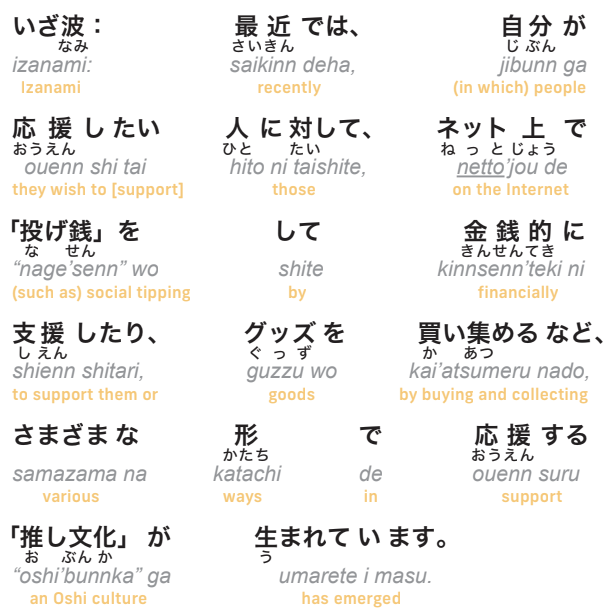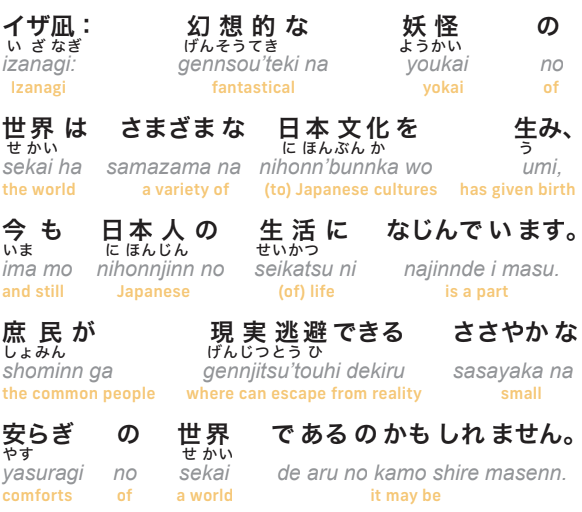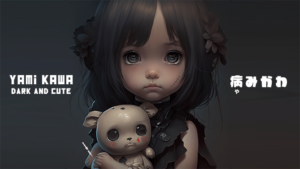Author: Katsuyuki Hasegawa
Nihongo Sprit Series : Japanese Mythology
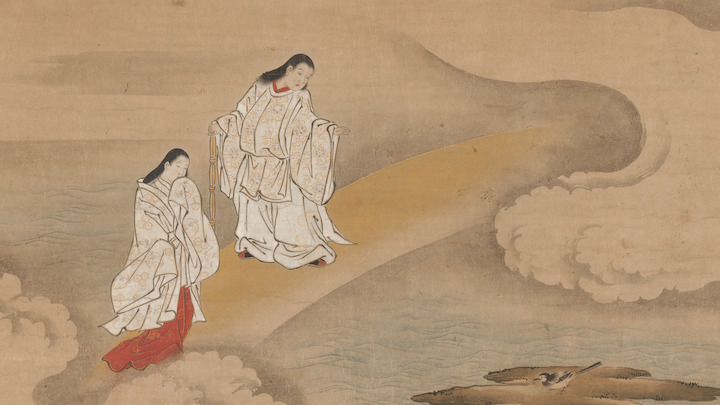
Warming up Audio
Keywords
| Japanese Word | Furigana | English Word | Example Sentence (Japanese & English) |
|---|---|---|---|
| 疫病封じの妖怪 | えきびょうふうじのようかい | plague-preventing monster | 疫病を防ぐために描かれた疫病封じの妖怪アマビエが流行した A plague-preventing monster, Amabie, that was drawn to prevent an epidemic became popular. |
| 妖怪 | ようかい | monster, demon, spirit | 日本人は古代からさまざまな妖怪を生み出してきました。 Japanese people have created various monsters since ancient times. |
| 河童 | かっぱ | kappa (a mythical water creature) | 川に棲むといういたずら好きな河童は、日本の妖怪の中でも有名です。 The mischievous kappa, which lives in the river, is one of the famous Japanese monsters. |
| 鬼 | おに | ogre, demon | 災いの象徴とされる鬼などは誰もが知る妖怪で、日本人の生活にとけこんでいます。 Ogres, which are considered a symbol of disaster, are familiar monsters to everyone and are integrated into Japanese people's lives. |
| 昔話 | むかしばなし | folk tale | 日本の代表的な昔話「桃太郎」は、桃太郎が鬼を退治する物語です。 Japan's representative folktale, Momotaro, is a story about Momotaro defeating an ogre. |
| 節分 | せつぶん | Setsubun (a festival held on February 3rd to drive away evil spirits) | 2月初旬の行事、「節分」では、家庭から鬼を追い出す豆まきが行われます。 During Setsubun, a festival held in early February, people throw beans to drive out ogres from their homes. |
| 擬人化する | ぎじんかする | personification | 日本には妖怪や動物、モノまでも擬人化する文化があります。 In Japan, there is a culture of personification of monsters, animals, and even objects. |
| 民話 | みんわ | folklore | ヨーロッパの民話は文化風俗を反映した話が多いのですが、日本の昔話はストーリー展開で楽しませる物語の要素が強いといえます。 European folktales often reflect cultural customs, while Japanese folktales emphasize entertaining stories. |
| 妖怪話 | ようかいばなし | monster story | 日本の地方にはさまざまな妖怪話がたくさん残っています。 There are many different yokai tales remaining in the regions of Japan. |
Let's build up your reading skill
 Izanami (いざ波)
Izanami (いざ波)
An illustration depicting Amabie, a plague-fighting yokai, went viral in Japan during the Covid-19 disaster.
疫病封じの妖怪、アマビエを描いたイラストが、コロナ禍の日本で流行しました。
 Izanagi (いざ凪)
Izanagi (いざ凪)
Japanese people have created various kinds of yokai since ancient times. The history of Japan begins with myths in which yokai appear.
日本人は古代からさまざまな妖怪を生み出してきました。日本の歴史は妖怪が登場する神話から始まります。
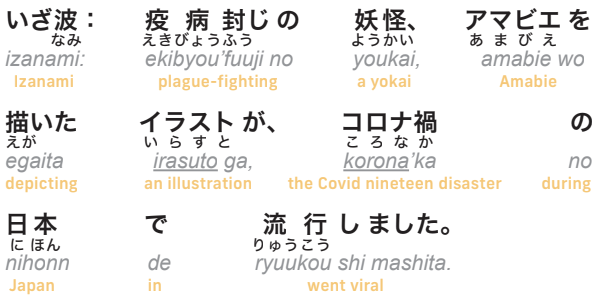
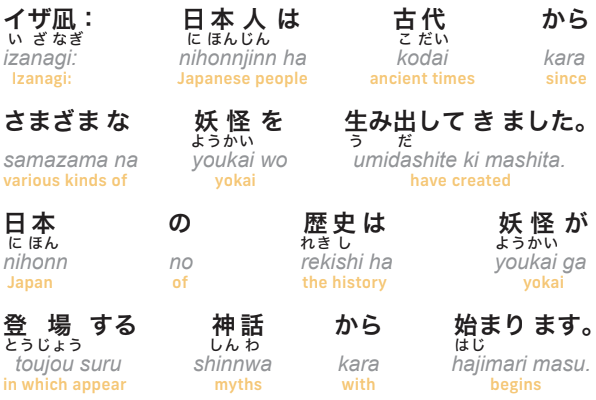
 Izanami (いざ波)
Izanami (いざ波)
The mischievous kappa, which live in rivers, and oni (ogres), which are symbols of misfortune, are well-known yokai and have become a part of Japanese peopleʼs lives.
川に棲むといういたずら好きな河童や、災いの象徴とされる鬼などは誰もが知る妖怪で、日本人の生活にとけこんでいます。
 Izanagi (いざ凪)
Izanagi (いざ凪)
“Momotaro,” a typical Japanese folktale, tells the story of Momotaro, who conquers oni. “Setsubun,” an event held in early February, is a time for bean-throwing to drive out oni from the home, as illness and troubles are likened to oni.
日本の代表的な昔話「桃太郎」は、桃太郎が鬼を退治する物語です。2月初旬の行事、「節分」では、病気や煩悩を鬼に例え、家庭から鬼を追い出す豆まきが行われます。
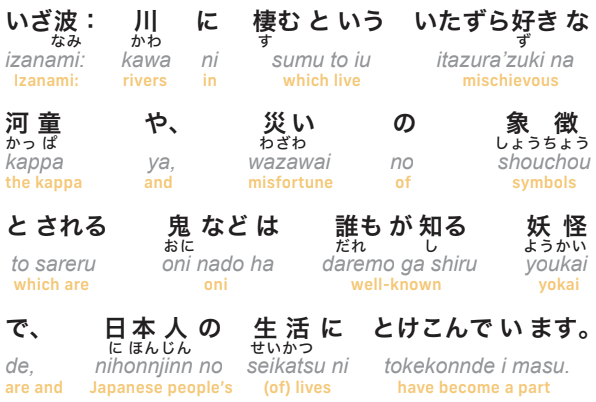
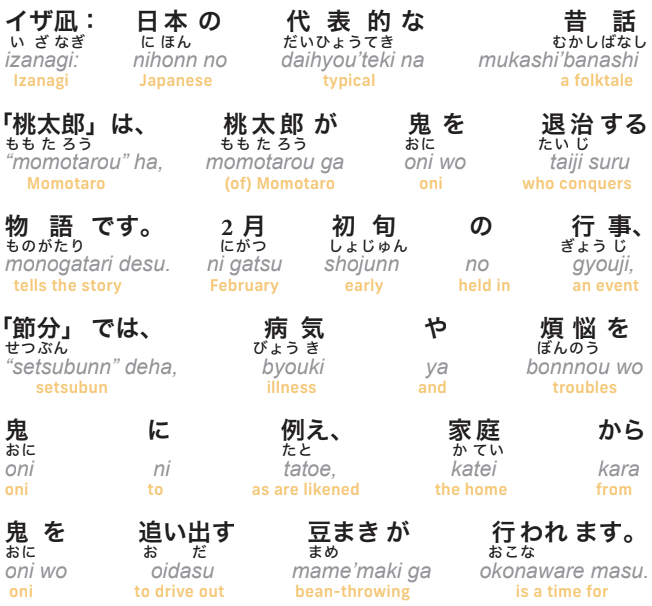
 Izanami (いざ波)
Izanami (いざ波)
A dog, a monkey, and a pheasant appear in Momotaroʼs stories as companions to exterminate oni; there are also many anthropomorphic animals in Japanese folktales such as “Sarukani Gassen” and “Kachikachiyama.”
桃太郎の鬼退治のお供として犬、猿、キジが登場します が、「さるかに合戦」や「かちかち山」など、日本の昔話には擬人化した動物もたくさん出てきます。
 Izanagi (いざ凪)
Izanagi (いざ凪)
Japan has a culture of anthropomorphizing yokai, animals, and even things.
日本には妖怪や動物、モノまでも擬人化する文化があります。
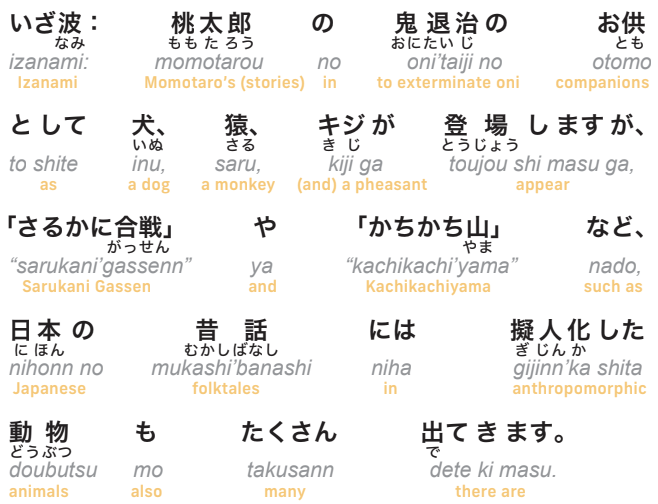

 Izanami (いざ波)
Izanami (いざ波)
European folk tales often reflect the cultural customs of the time, while Japanese folktales have a strong element of storytelling that entertains through story development.
ヨーロッパの民話は文化風俗を反映した話が多いのですが、日本の昔話はストーリー展開で楽しませる物語の要素が強いといえます。
 Izanagi (いざ凪)
Izanagi (いざ凪)
There are many tales of various yokai remaining in the regions of Japan.
日本の地方にはさまざまな妖怪話がたくさん残っています。
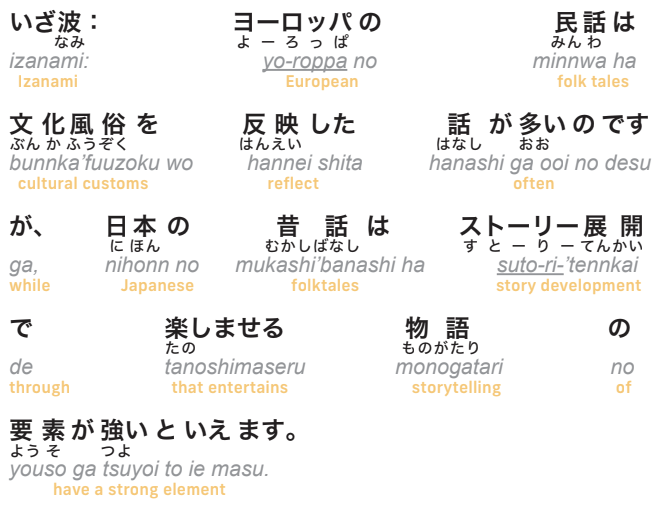
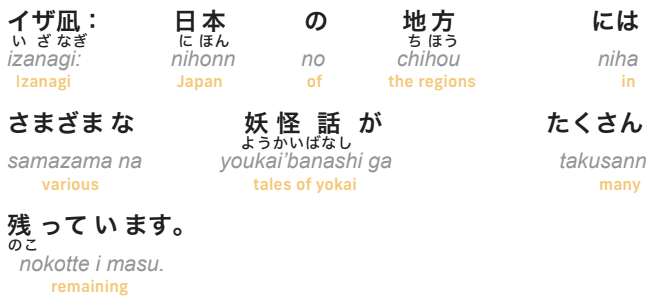
 Izanami (いざ波)
Izanami (いざ波)
Izanami: “Tono Monogatari” (The Legends of Tono) by YANAGITA Kunio is a well-known collection of folklore and anecdotes from the Tono region of Iwate Prefecture, including “zashiki-warashi.”
「座敷童」をはじめ、岩手県遠野地方の伝承や逸話を集めた柳田国男の「遠野物語」はよく知られています。
 Izanagi (いざ凪)
Izanagi (いざ凪)
Lafcadio HEARN (a Greek-born English man known as KOIZUMI Yakumo) wrote“KAIDAN / Kwaidan (ghost story)” based on legends from various parts of Japan that he heard from his Japanese wife.
ラフカディオ・ハーン(小泉八雲の名で知られるギリシャ 生まれのイギリス人)は、日本人の妻から聞いた日本各の 伝説などをもとに「怪談」を書きました。
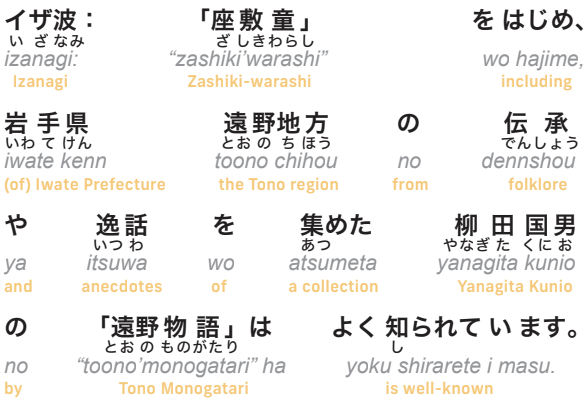
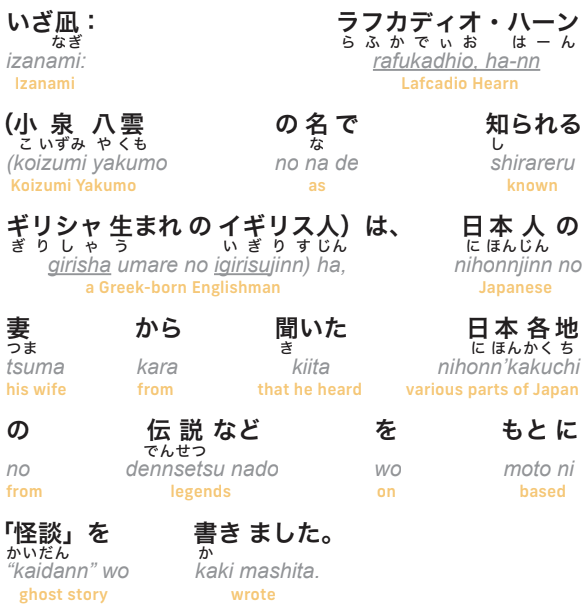
 Izanami (いざ波)
Izanami (いざ波)
Among Hearnʼs works, "YUKI-ONNA (snow woman),” which depicts a beautiful specter, and “Miminashi Hoichi,” (Hoichi the Earless) a story about the grudge spirits of the Heike clan, are ghost stories that many Japanese are familiar with.
ハーンの作品の中でも、美しい妖怪を描いた「雪女」や、平家の怨霊にまつわる物語「耳なし芳一」は、日本人の多くが知る怪談話です。
 Izanagi (いざ凪)
Izanagi (いざ凪)
Japanese people have incorporated stories featuring yokai into their daily lives. Personification of yokai and animals brings familiarity, it is also found in contemporary subcultures.
日本人は妖怪が登場する物語を生活の中に取り入れてきました。妖怪や動物の擬人化は親したしみをもたらし、それは、現代のサブカルチャーにも見られます。
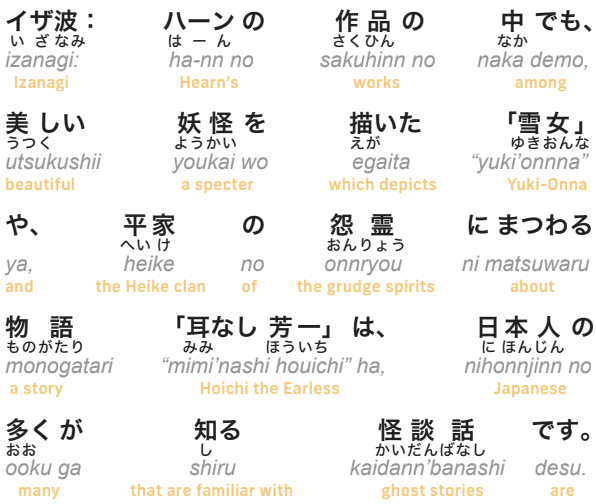
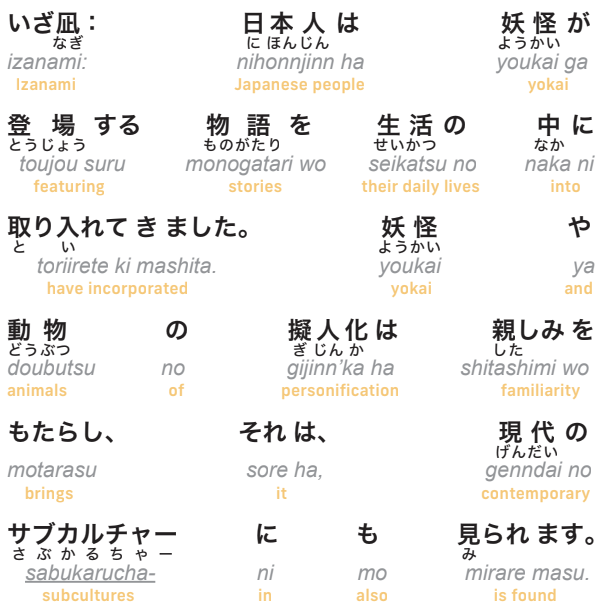
 Izanami (いざ波)
Izanami (いざ波)
Manga and TV character goods in which main characters transform into heroes, as well as “yuru kyara” characters that have become mascots in various parts of Japan, are very popular.
主人公が変身するまんがやテレビのキャラクターグッズ、また、日本各地のマスコットとなっている「ゆるキャラ」は大人気です。
 Izanagi (いざ凪)
Izanagi (いざ凪)
Manga and anime depicting the world of yokai, such as MIZUKI Shigeruʼs “Gegege no Kitaro” and GOTOUGE Koyoharuʼs “Kimetsu no Yaiba (Demon Slayer)” have been popular throughout the ages.
水木しげるの「ゲゲゲの鬼太郎」や吾峠呼世晴の「鬼滅の刃」をはじめ、妖怪の世界を描いたまんがやアニメは、時代を超えて人気です。
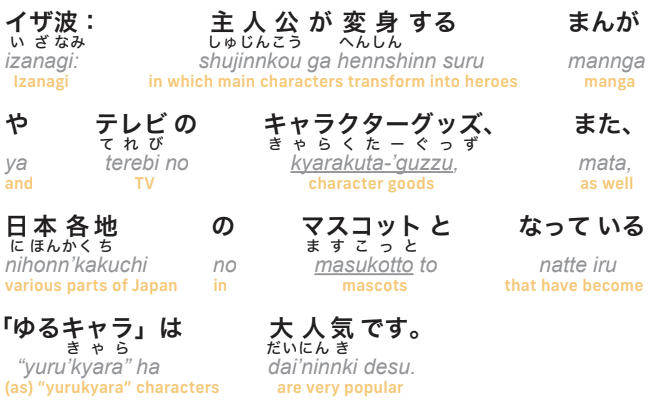
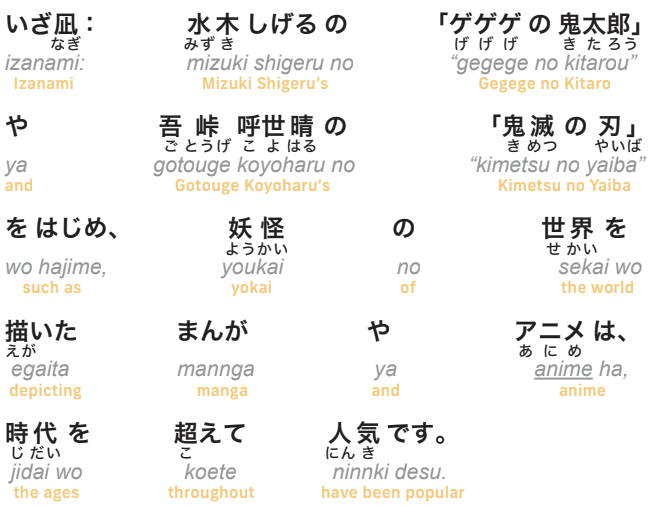
 Izanami (いざ波)
Izanami (いざ波)
This Japanese preference has given rise to a unique Japanese culture of cosplay and figurines.
このような日本人の嗜好性が、コスプレやフィギュアといった特徴的な日本文化を生みました。
 Izanagi (いざ凪)
Izanagi (いざ凪)
Furthermore, it could be said to have led to idol culture and “kawaii (cute)” culture.
それがさらに、アイドル文化、「かわいい」文化にもつながっていったと言えるでしょう。
 Izanami (いざ波)
Izanami (いざ波)
When we think of idols in Japan, we think of “local idols” or “Akiba style idols,” who are more like “the sister or brother (the boy or girl) next door” that you can meet anytime, rather than excellent singers.
日本でアイドルと言えば、優れた歌手というより、いつでも会える「隣のおねえさん、おにいさん」的な存在で、「ローカルアイドル」や「アキバ系アイドル」を連想します。
 Izanagi (いざ凪)
Izanagi (いざ凪)
Japanese idol fans support idols from their debut and enjoy the process of their growth as top idols.
日本のアイドルファンは、デビューしたてから応援し、トップアイドルとして成長していく過程を楽しみます。
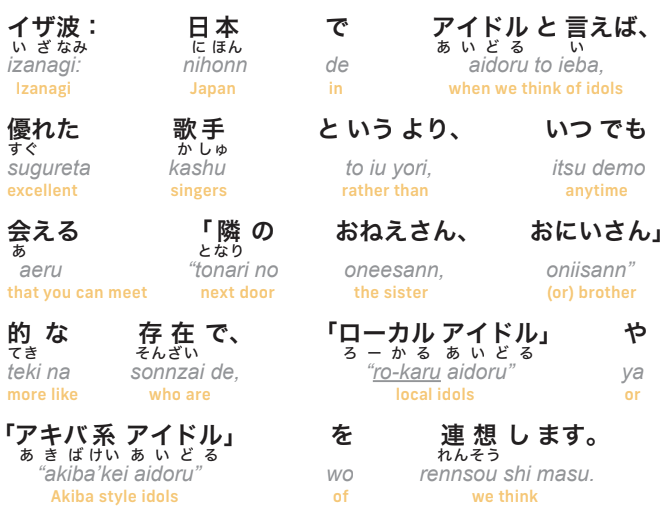
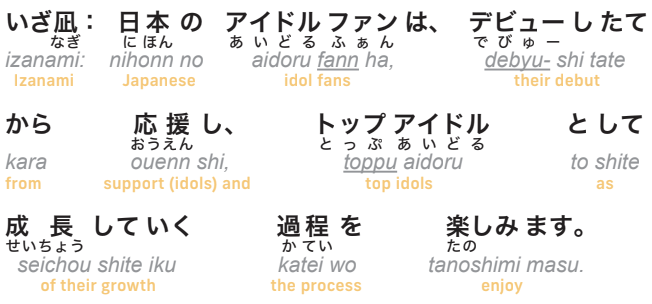
 Izanami (いざ波)
Izanami (いざ波)
Recently, an “Oshi (fave) culture” has emerged in which people support those they wish to in various ways, such as by “social tipping” on the Internet to support them financially or by buying and collecting goods.
最近では、自分が応援したい人に対して、ネット上で「投げ銭」をして金銭的に支援したり、グッズを買い集めるなど、さまざまな形で応援する「推し文化」が生まれています。
 Izanagi (いざ凪)
Izanagi (いざ凪)
The fantastical world of yokai has given birth to a variety of Japanese cultures and is still a part of Japanese life. It may be a world of small comforts where the common people can escape from reality.
幻想的な妖怪の世界はさまざまな日本文化を生み、今も日本人の生活になじんでいます。庶民が現実逃避できるささやかな安らぎの世界であるのかもしれません。
